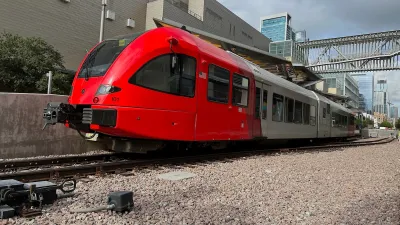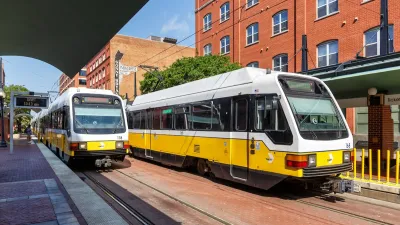Patrick Kennedy proposes an elegant and cost-effective way to deal with Dallas's aging elevated freeway and the city's "massive pent-up demand for walkable urban housing" - tear the sucker down.
The Texas Department of Transportation is considering two solutions for the aging 1.4 mile elevated freeway (IH-345) that runs between downtown and Deep Ellum: "either keep repairing the old road or rebuild it entirely, at a price likely in the hundreds of millions."
"There is a third option, though," argues Kennedy, "and it’s not getting the consideration it deserves." After two years of studying the IH-345 area, its traffic patterns, and the potential for redevelopment, he and a friend in real estate development have concluded that the best option is to tear the freeway down. He supports his position with an examination of the regional, local, short term, and long term impacts on traffic.
"Just as the system of freeways has shifted population outward, removing IH-345 from downtown would draw people into the city. It would reposition 245 acres so that it could be developed into walkable neighborhoods that could be home to 20,000 new downtown residents. Right now there is only $19 million in improvements on those 245 acres, and the city collects a mere $3 million per year in property tax revenue. By removing the highway, restitching the grid, and creating developable blocks, the city would see $4 billion in new investment within 15 years and generate $100 million a year in property tax revenue, based on our economic impact analysis."
"In order to set off the kind of building boom required to meet the massive pent-up demand for walkable urban housing," concludes Kennedy, "we must flip the downtown real estate equation so land costs are lowered and demand is increased. To do that, we must leverage the commonwealth’s best asset: land. Forget the traffic."
FULL STORY: How Dallas is Throwing Away $4 Billion

Alabama: Trump Terminates Settlements for Black Communities Harmed By Raw Sewage
Trump deemed the landmark civil rights agreement “illegal DEI and environmental justice policy.”

Planetizen Federal Action Tracker
A weekly monitor of how Trump’s orders and actions are impacting planners and planning in America.

Why Should We Subsidize Public Transportation?
Many public transit agencies face financial stress due to rising costs, declining fare revenue, and declining subsidies. Transit advocates must provide a strong business case for increasing public transit funding.

Understanding Road Diets
An explainer from Momentum highlights the advantages of reducing vehicle lanes in favor of more bike, transit, and pedestrian infrastructure.

New California Law Regulates Warehouse Pollution
A new law tightens building and emissions regulations for large distribution warehouses to mitigate air pollution and traffic in surrounding communities.

Phoenix Announces Opening Date for Light Rail Extension
The South Central extension will connect South Phoenix to downtown and other major hubs starting on June 7.
Urban Design for Planners 1: Software Tools
This six-course series explores essential urban design concepts using open source software and equips planners with the tools they need to participate fully in the urban design process.
Planning for Universal Design
Learn the tools for implementing Universal Design in planning regulations.
Caltrans
Smith Gee Studio
Institute for Housing and Urban Development Studies (IHS)
City of Grandview
Harvard GSD Executive Education
Toledo-Lucas County Plan Commissions
Salt Lake City
NYU Wagner Graduate School of Public Service




























